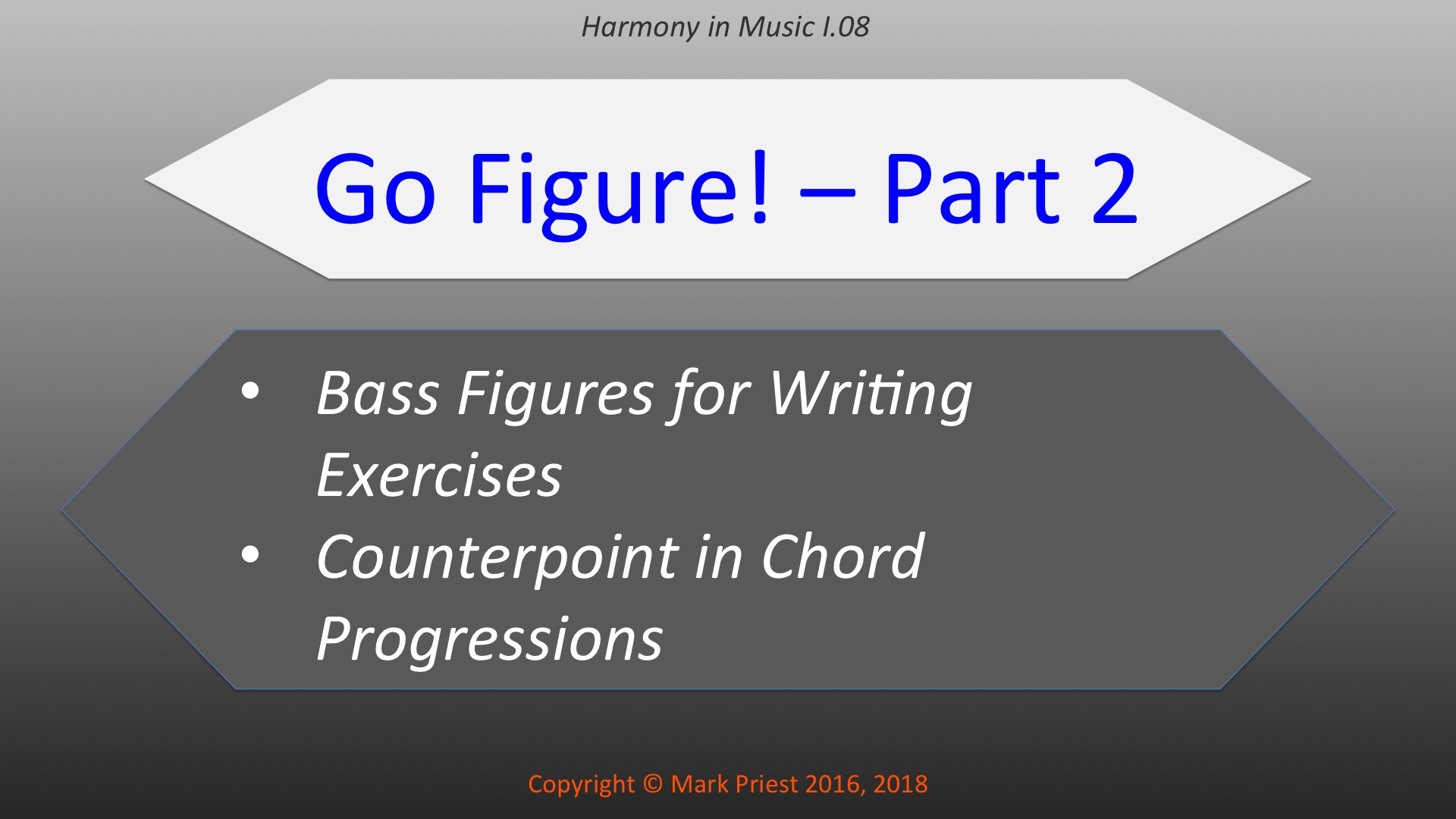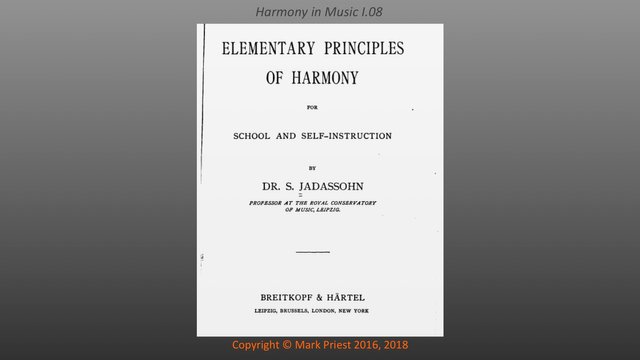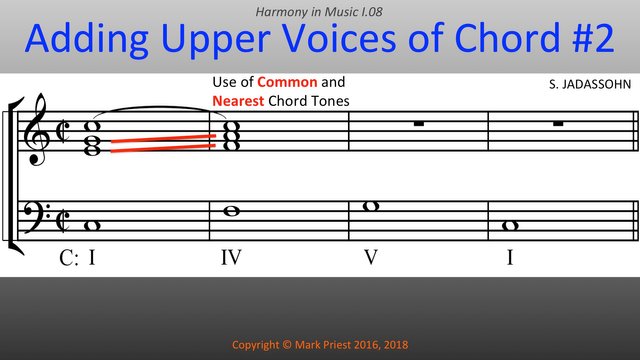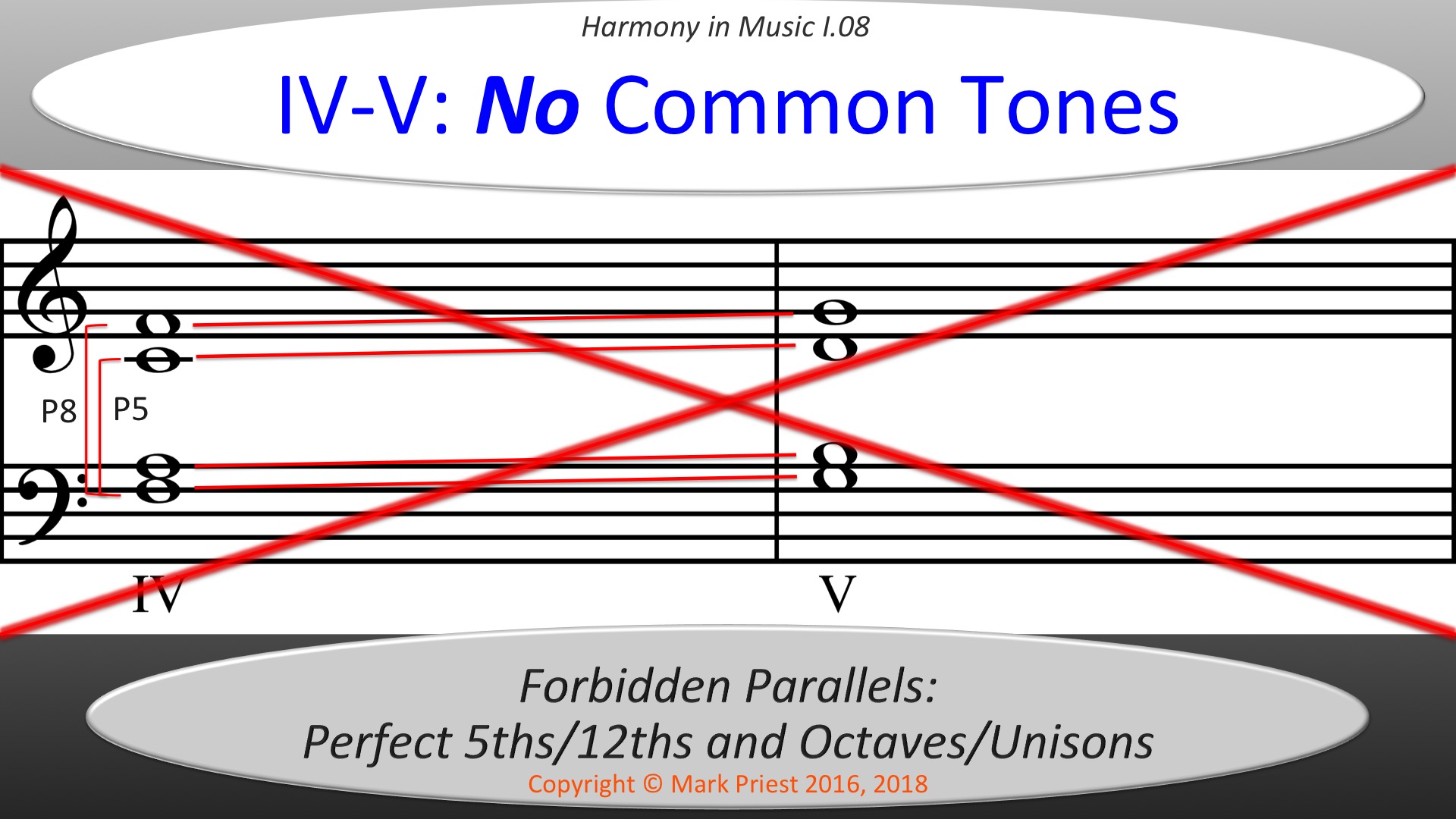Meaning of Bass Figures - Harmony I.08 (Updated Slides and Transcript)
We recently introduced [in "Go Figure!, Part 1"] numbering of the starting bass note of a chord progression, using both Roman numerals and Arabic figures.

To illustrate how this works in practice, we now dissect an example.
This one comes from Professor Salomon Jadassohn's theory textbook, ...

Elementary Principles of Harmony, published in 1895.
A reference to this book is listed in the Description box.

Let’s pretend that each one of these chords [above] is the start of an exercise. Here are the guidelines for figuring the bass:
- When the soprano doubles the bass at either the octave or double octave, no figures are required.
- the Arabic figure 3 or 5 is added to the last two chords, because the soprano is a third or fifth above the bass note.
As a visual reminder, we present the upper voices of this example in C-clefs: Soprano, Alto, and Tenor. You may wish to transcribe these parts to a Grand Staff, for your own practice.

In close position, the Alto takes the very next chord tone below the Soprano. In these four chords, respectively, the fifth, the fifth, the tonic, and the third. Hear how the Alto sounds when combined with Soprano and Bass. [play]

Still in close position, the Tenor takes the next chord tone below the Alto. In the four chords, the Tenor sings, respectively, the third, the third, the fifth, and the octave of the bass. Listen to Tenor alone. [play] Now, to the four voices combined. [play] And in this way we have equal counterpoint in four voices!

We can be more specific with our numbers on the first chord, by adding various combinations of figures: 8, 5/3 reading from top to bottom, 8/5/3, 3/5/8, or 5/3/8. How might such figures play out in practice?

Such detailed figuring applies only to the initial bass tone of an exercise, not to every chord in the progression. We are using these figures as a shorthand to designate the notes of just the first chord of an exercise, from which you, the student, will have to work out the individual voice parts. [play] See how each Arabic numeral tells the exact interval from the Bass note to an upper note of the chord.

From chord to chord, students must follow the Rules of Four-Part Voice Leading, or counterpoint. Later on, we’ll introduce you to a comprehensive figured bass system perfected centuries before the chord symbols of modern popular music.

One more thing: Until further notice, the bass note will always be the root of each triad. Listen to this bass progression. [play it] Restricting ourselves to close position chords, how might we work it out in four-part harmony? Applying the Rules of the game, here is the play-by-play:

The tonic triad in this key is spelled C E G, which is DO-MI-SOL. No Arabic figures over the first bass note means the soprano doubles the note C (which is the DO of the I chord). For the first triad, we will double the DO at the double-octave. [play it] Double! [again]

Alto and Tenor are added immediately below the Soprano. When restricted to close position, there must be no “openings” - no chord tone gaps - from Tenor to Soprano. [play]
First chord complete.

The IV chord in this key is spelled F A C, or FA-LA-DO. This is a circle-of-fifths progression, so according to our Rules for independent voice leading, the Soprano must prolong the common tone C or DO into the second chord.
The Alto and Tenor voices move to A and F, LA and FA, respectively, because these are the nearest tones of that chord. Hear it? [play] The Tenor moving to F also takes care of doubling the Bass at the octave. Doubling!
Second chord complete.

On to the challenge of progressing from IV to V, subdominant to dominant, the third and fourth chords in this progression. The V chord is spelled G B D, or SOL-TI-RE. There are no common tones between IV and V, which is a flag. Parallel 5ths and 8vas like these [play] are not an option, so instead, we have to use contrary motion between Bass and upper voices.

Therefore, as the Bass moves up, from F to G, FA-SOL, the three upper voices must move down, to the nearest tones of the V chord. Such contrary motion between bass and upper voices is how we avoid unwanted parallel fifths and octaves (or unisons). [play]
Third chord complete.

Now for the progression from dominant back to tonic. Observe that the move from V to I is like I to IV, a circle-of-fifths progression: Keep the common tone of G (SOL) in the Alto, while moving the Soprano and Tenor to the nearest tones of the tonic chord. Bass doubling is again covered by the soprano. [play]
Final chord complete.

Now for a “what if” scenario. What if, on the first chord, the Soprano doubles the Bass at the first octave, instead of the double-octave? Do you foresee a problem here?

The Soprano and Alto are now at the extreme low end of, if not outside of, their normal range, and at one point, the Tenor even crosses below the Bass. This is not generally a good idea for realistic-sounding choral writing, since it is nearly impossible to achieve a balanced, harmonious sound at the extreme high or low ends of any instrument or voice range. [play]

Relevantly, here is another Rule for practice exercises: No voice should cross below a lower voice on the same chord, and, never cross below the Bass voice.
Do you understand why? Think about it.

Moving on to show you another sample exercise, and its solution. [play] By the way, that strange symbol in the last measure is called a fermata; just think of it as a stop sign along the road. We do hope you take the time to play through this and the previous examples on your piano keyboard!

For a whole slew of examples already worked out, we refer you to the book Elementary Principles of Harmony, by Dr. Jadassohn. pp. 27-29. You can probably find a pdf or e-book of this out-of-print textbook, which is out of copyright, and in the Public Domain. See also the Description accompanying this [presentation].

If you have a question or suggestion for a relevant future topic, feel free to post a comment below the video.
Subscribe to the [DTube] channel for updates, and share with [resteem for] someone who would like to learn.
Keep reviewing the Channel Playlists, practicing, and listening.
Thank you for your attention!

Philosophy: "Discipline, work. Work, discipline." – Gustav Mahler
LINKS AND REFERENCES
WATCH the DTube VIDEO Version of the above:
https://d.tube/v/monadnock/yvc42j3r
Jadassohn, Dr. Salomon. Elementary Principles of Harmony for School and Self-Instruction. Breitkopf and Hartel, 1895. A Public Domain work.
Internet Archive Link – must copy and paste – for download of same:
https://archive.org/details/elementaryprinc00goog
IMAGE CREDIT
Cape Town Stadium: https://flic.kr/p/7y3t65
Creative Commons License: https://creativecommons.org/licenses/by-sa/2.0/legalcode
Public Domain Mark: https://creativecommons.org/publicdomain/mark/1.0/
CODA
Donations to support this blog beyond the current 7-day limit will be put to productive and relevant use!